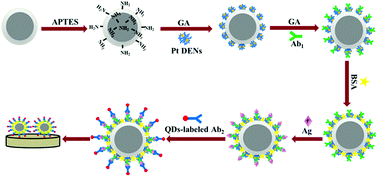Our official English website, www.x-mol.net, welcomes your
feedback! (Note: you will need to create a separate account there.)
Enhanced anodic electrochemiluminescence of CdTe quantum dots based on electrocatalytic oxidation of a co-reactant by dendrimer-encapsulated Pt nanoparticles and its application for sandwiched immunoassays
Analyst ( IF 3.6 ) Pub Date : 2017-09-04 00:00:00 , DOI: 10.1039/c7an01231d Lu-Lu Ren 1, 2, 3, 4 , Hao Dong 1, 2, 3, 4 , Ting-Ting Han 1, 2, 3, 4 , Yun Chen 4, 5, 6, 7 , Shou-Nian Ding 1, 2, 3, 4
Analyst ( IF 3.6 ) Pub Date : 2017-09-04 00:00:00 , DOI: 10.1039/c7an01231d Lu-Lu Ren 1, 2, 3, 4 , Hao Dong 1, 2, 3, 4 , Ting-Ting Han 1, 2, 3, 4 , Yun Chen 4, 5, 6, 7 , Shou-Nian Ding 1, 2, 3, 4
Affiliation

|
Herein, we synthesized Pt dendrimer-encapsulated nanoparticles (Pt DENs) using amine-terminated sixth-generation polyamidoamine dendrimers. The enhanced and stable anodic electrochemiluminescence (ECL) of 3-mercaptopropionic acid-capped CdTe quantum dots (QDs) in a tripropylamine solution was achieved owing to Pt DENs. The reason may be that Pt DENs exhibit high catalytic electrochemical oxidation in the presence of tripropylamine and excellent conductive property. Inspired by this, Pt DENs were conjugated with Fe3O4@SiO2 nanoparticles and served as nano-carriers. The capture antibodies were immobilized on the Fe3O4@SiO2-Pt DEN nanocomposites, which possess many attractive advantages such as the ease of bioconjugation, large specific surface area, and convenience of magnetic separation. Fluorescence microscopy images and UV-vis spectra were used to verify the immobilization of capture antibodies on the nanocomposites. The CdTe QDs were applied as signal labels for conjugation of nanocomposites with detection antibodies, which were characterized by agarose gel electrophoresis. Electrochemical impedance spectroscopy and cyclic voltammetry demonstrated the successful preparation of an ECL immunosensor. Under the optimal conditions, the proposed immunosensor provided a wide linear range from 0.005 ng mL−1 to 150 ng mL−1 with a detection limit of 0.2 pg mL−1 (S/N = 3) for the detection of carcinoembryonic antigen. Moreover, the immunosensor showed good performance for the detection of carcinoembryonic antigen in serum samples as well as great potential in clinical bioassay.
中文翻译:

树枝状聚合物包裹的Pt纳米粒子对共反应物的电催化氧化作用增强CdTe量子点的阳极电化学发光及其在夹心免疫分析中的应用
在这里,我们使用胺封端的第六代聚酰胺型胺树枝状大分子合成了Pt树枝状大分子包封的纳米颗粒(Pt DENs)。由于Pt DENs,在丙丙胺溶液中实现了3-巯基丙酸封端的CdTe量子点(QDs)的增强和稳定的阳极电化学发光(ECL)。原因可能是在三丙胺存在下,Pt DENs表现出高催化电化学氧化性和优异的导电性能。受此启发,Pt DENs与Fe 3 O 4 @SiO 2纳米颗粒共轭并用作纳米载体。捕获抗体固定在Fe 3 O 4 @SiO 2上-Pt DEN纳米复合材料,具有许多吸引人的优势,例如生物共轭的容易性,大的比表面积和磁分离的便利性。荧光显微镜图像和紫外可见光谱用于验证捕获抗体在纳米复合材料上的固定。CdTe QDs用作信号标记,用于纳米复合物与检测抗体的缀合,其通过琼脂糖凝胶电泳进行表征。电化学阻抗谱和循环伏安法证明了ECL免疫传感器的成功制备。在最佳条件下,建议的免疫传感器可提供0.005 ng mL -1至150 ng mL -1的宽线性范围,检测限为0.2 pg mL -1(S / N = 3)用于检测癌胚抗原。此外,该免疫传感器在检测血清样品中的癌胚抗原方面表现出良好的性能,并且在临床生物测定中具有巨大的潜力。
更新日期:2017-09-21
中文翻译:

树枝状聚合物包裹的Pt纳米粒子对共反应物的电催化氧化作用增强CdTe量子点的阳极电化学发光及其在夹心免疫分析中的应用
在这里,我们使用胺封端的第六代聚酰胺型胺树枝状大分子合成了Pt树枝状大分子包封的纳米颗粒(Pt DENs)。由于Pt DENs,在丙丙胺溶液中实现了3-巯基丙酸封端的CdTe量子点(QDs)的增强和稳定的阳极电化学发光(ECL)。原因可能是在三丙胺存在下,Pt DENs表现出高催化电化学氧化性和优异的导电性能。受此启发,Pt DENs与Fe 3 O 4 @SiO 2纳米颗粒共轭并用作纳米载体。捕获抗体固定在Fe 3 O 4 @SiO 2上-Pt DEN纳米复合材料,具有许多吸引人的优势,例如生物共轭的容易性,大的比表面积和磁分离的便利性。荧光显微镜图像和紫外可见光谱用于验证捕获抗体在纳米复合材料上的固定。CdTe QDs用作信号标记,用于纳米复合物与检测抗体的缀合,其通过琼脂糖凝胶电泳进行表征。电化学阻抗谱和循环伏安法证明了ECL免疫传感器的成功制备。在最佳条件下,建议的免疫传感器可提供0.005 ng mL -1至150 ng mL -1的宽线性范围,检测限为0.2 pg mL -1(S / N = 3)用于检测癌胚抗原。此外,该免疫传感器在检测血清样品中的癌胚抗原方面表现出良好的性能,并且在临床生物测定中具有巨大的潜力。











































 京公网安备 11010802027423号
京公网安备 11010802027423号